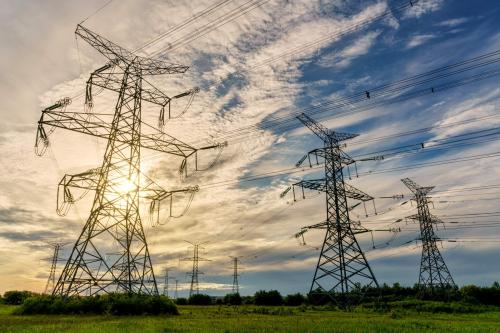President Obama signs Electrify Africa Act into law
After two years of deliberations—and recently, its unanimous passage in both the United States House of Representatives and Senate—President Obama signed the Electrify Africa Act into law on Monday, February 8, 2016. The new law ratifies support for the Power Africa initiative, which was launched in June 2013 to expand power generation and distribution across sub-Saharan Africa. Capitalizing on public-private partnerships and U.S. government guarantees, Power Africa has already raised approximately $50 billion in commitments for African power projects: $7 billion from the U.S. government, mostly in financing through the U.S. Export-Import Bank, and $43 million from over 120 private sector, multilateral, and foreign government partners.
Last week, the initiative released a roadmap to increase generation capacity in Africa by 30,000 MW and connect 60 million new households and businesses to electricity by 2030. The roadmap highlights Power Africa’s progress to date, as well as several key strategies moving forward, including: increasing support for projects in their early stages such as Beyond the Grid, a project which sets out to address the electricity access gap in Tanzania; improving “deal flows” (the rate at which business proposals and investment offers reach the table) in technologies with far-reaching potential, especially renewables; boosting generation activity at underutilized power plants through repairs and improved plant management; and establishing the regulatory conditions and financial and technical support for implementing large-scale, on-grid and off-grid roll-out programs.
While many observers have applauded the Power Africa Roadmap and passage of the Electrify Africa Act for outlining concrete steps toward ending energy poverty in Africa, they have also suggested a few areas for improvement, including reforming the Overseas Private Investment Corporation in support of the Electrify Africa Act and providing additional clarity on the limits to investments in fossil fuel for electricity generation.
Ethiopia, Somalia, and South Sudan face acute food shortages
Conflict and natural disasters have put several East African countries at risk of famine. In Ethiopia, South Sudan, and Somalia, millions of people are becoming increasingly exposed to food insecurity. In fact, last December, Ethiopia appealed for $1.4 billion in food aid, but so far the appeal has only raised $680 million. Many believe the region is posed for a catastrophe, as Save the Children has emphasized: “The international community has just three weeks to provide $245 million in emergency food aid to help prevent a potentially catastrophic escalation in severe acute malnutrition (SAM) case.”
Similarly, on Monday, the United Nations Office for the Coordination of Humanitarian Affairs (OCHA) issued a press release noting the alarming food security and malnutrition situation in Somalia and the urgent need for attention. OCHA claims that 40 percent of Somalia’s population, that is 4.7 million people, is in need of humanitarian assistance. The figures estimate that nearly 950,000 are acutely food insecure and face difficulties in meeting their daily food needs. Internally displaced people in Somalia are notably vulnerable to food insecurity.
While the El Niño-induced drought is the main cause behind the food crisis in Ethiopia, the food crisis in South Sudan is caused mainly[MS1] by war (in Somalia, both factors play an enabling role). Indeed, the U.N.’s Food and Agriculture Organization (FAO) attributes food insecurity in South Sudan to conflict-driven price inflation and market disruptions. In that country 2.8 million people are in urgent need of food aid, with 40,000 of them starving to death. The FAO is particularly worried about the situation in South Sudan, as hunger increased in the post-harvest period, when the country usually has the most food. The FAO calls for the prompt implementation of the peace agreement as it is critical to the resolution of the food crisis in South Sudan.
Egypt pulls out of regional power pool amid Nile River dispute
This week, Egypt announced its withdrawal from the East Africa regional power pool (EAPP), citing the already contentious issue of dams along the Nile River, its only source of freshwater. Established in 2005, the EAPP aims to reduce electricity costs in the region while promoting power exchanges by assembling these country’s resources and create regional power interconnections, therefore easing the distribution of power throughout the region. The EAPP consists of 10 East and North African countries (Burundi, Democratic Republic of Congo, Egypt, Ethiopia, Kenya, Rwanda, Sudan, Tanzania, Libya, and Uganda) and is funded by the member states, World Bank, African Development Bank, and U.S. government.
However, in a recent Council of Ministers meeting in Addis Ababa, Egypt refused to sign the master plan over the construction of hydropower projects along the Nile River, the country’s only source of fresh water and a key source of supply to its agricultural sector. Notably, Ethiopia and Sudan have used the Nile River for generating hydropower, and control over the use of the Nile’s waters has created immense friction among these three countries.
The master plan includes the construction of transmission lines between countries, thus promoting interconnectivity and allowing countries to sell their excess electricity to their neighbors. The secretary-general of the EAPP, Lebi Changullah, issued a statement noting that the project has been approved by the other member states and will go on despite Egypt’s concerns.
For a more in-depth look at the conflict over the Nile River, please consult Mwangi Kimenyi and John Mbaku’s book Governing the Nile River Basin: The Search for a New Legal Regime.



Commentary
Africa in the News: Electrify Africa becomes US law, famine looms over Horn of Africa, and Egypt pulls of regional power pool
February 12, 2016